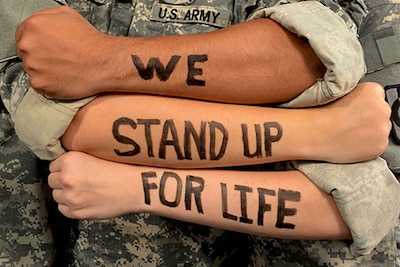By John Reese, U.S. Army Garrison Stuttgart
STUTTGART, Germany, Sept. 13, 2017 — September is Suicide
Prevention Month, and with it comes greater awareness that it's possible there
are friends, comrades and family members who may be considering that
irreversible decision.
Someone who is considering suicide may display a number of
behavioral indicators, according to officials with the Employee Assistance
Program at U.S. Army Garrison Stuttgart. Some are direct, they said, while
others are subtle enough to be missed until it is too late.
The garrison's EAP and Army Substance Abuse Program have
teamed up this month to enhance suicide prevention awareness, beginning with a
resource table at the Panzer Kaserne post exchange.
"This is a time for sharing and caring to support
service members, veterans and civilian families who have lost their loved
ones," said Kaffie Clark, EAP coordinator here. "Volunteers will be
giving out yellow ribbons at the Panzer Kaserne front gate to remember our
loved ones, our soldiers and those who lost their lives."
Suicide Statistics
Clark and Cinda Robison, ASAP prevention coordinator, have
access to the most recent Army suicide statistics, giving them a bigger picture
of the severity of military suicides.
Robison shared a story about meeting a young soldier who was
behaving in a peculiar manner, allowing others again and again to pass her in a
line when she was already halfway through a common task. When Robison commented
on the soldier's patience, she opened up and explained how a recent change in
duty station and other factors had caused extreme exhaustion. Robison became
concerned.
"Sometimes it isn't the usual signs -- giving away
valuables, putting affairs in order, loss of enthusiasm and hope, et cetera --
when a person is considering suicide," Robison explained.
A scholarly study sponsored in part by the Army and
published in the Journal of American Medical Association, July 26, 2017, found
that previous suicides in a unit increased the chances of a soldier committing
suicide, particularly with smaller units. The study used information from the
"Army Study to Assess Risk and Resilience in Service Members." It
focused on "all active-duty, regular U.S. Army enlisted soldiers who
attempted suicide from Jan. 1, 2004, through Dec. 31, 2009."
In that time frame, of the 9,512 enlisted suicide attempters
… 86.4 percent were male, 68.4 percent were 29 years or younger, 62.2 percent
were younger than 21 years when entering the army, 59.8 percent were white,
76.6 percent were high school educated, and 54.8 percent were currently
married. Almost three-quarters, or 72.2 percent, had more than two years of
service, 40.3 percent had never deployed, and 76.7 percent were assigned to an
occupation other than combat arms."
The highly-detailed study indicated the risk of suicide
attempts among soldiers is influenced by a history of suicide attempts within a
soldier's unit.
"Attention to unit characteristics by leadership and
service professionals may be a component in suicide attempt reduction efforts,”
according to part of the study’s conclusion.
Veterans
Suicide disproportionately affects veterans, Clark and
Robison noted. They pointed to a Veterans Affairs’ statistic from 2013 on the
suicide rate among veterans. Four years ago, veterans were committing suicide
at a rate of 22 per day, or one every 65 minutes. As shocking as that number
was, that study represented only 21 states; the two largest and fifth largest
states didn't provide data to the VA for the survey.
Common knowledge from the 2013 report indicates the number
of 22 per day didn't reflect the actual number of veterans who died by suicide,
Clark said.
"It's huge, the discrepancy," Robison added.
"It could've been as high as 35 suicides per day."
Since 2013, the number of recorded veteran suicides has
slowed a little. A VA report in 2016 using analysis from 2014 put the average
at 20 each day, or one every 72 minutes.
Physician Assistant’s Experience
On July 26, 2017 -- the same day the JAMA study was
published -- CNN interviewed retired Army physician assistant Maj. Marc Raciti,
who experienced post-traumatic stress disorder and came very close to hanging
himself after five deployments.
"I did lose three medics after coming back from Iraq to
suicide, which exasperated my PTSD, but mine is of survivor's guilt for the
ones I could not save," Raciti said.
In August, 2017, VA Secretary Dr. David Shulkin spoke about
a new and disturbing trend of veterans coming to a VA facility to commit
suicide.
"There are a number of reasons [for coming to the VA to
commit suicide], not all of which I completely understand," Shulkin said,
adding one of the reasons is "they don't want their families to have to
discover them. They know that if they're discovered at a VA, that we will
handle it in an appropriate way and take care of them."
Helping to prevent suicides in the Stuttgart military
community is everyone's job, said Clark and Robison. As Stuttgart is a joint
service community with many civilians and family members, suicide prevention
should be practiced by everyone regardless of branch, age or veteran status.
"To help bring awareness, yellow ribbons will be passed
out during September," Clark said. "After that, there will be an
Applied Suicide Intervention Skills Training workshop offered Sept.
26-27."

No comments:
Post a Comment